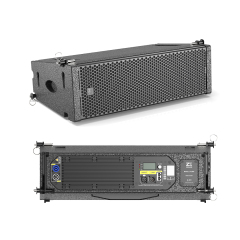Point source or Line array, each of these technologies represents a different way to develop audio reinforcement systems and has its advantanges in many applications. The main difference between these 2 systems is how they project the sound out which essentially does not work well for a live situation.
A typical point source speaker produces sound from a single point and projects it in 360 degrees on the horizontal plane, and sometimes --- depending upon design -- up to around 90 degrees on vertical axis. Point source speakers are perfect for smaller venues or environments that need a broad dispersion but without the focus on distance. Point source speakers are designed to project clear and even sound throughout a specific coverage area so they reasonable choices for low-power, small-to-moderate SPL applications like club shows corporate events or houses of worship.
On the other hand, line arrays comprise several speaker elements in a row (vertically aligned). The resulting wavefront is a cylindrical one, which allows line arrays to send the sound further and in a more consistent manner over longer distances. The line array is designed so that the vertical stacking of the speakers tightens from top to bottom, contributing to an increase in horizontal reach compared with point source cabinets; stadiums and outdoor festivals are ideal venues for a well-specified series of line arrays. A single line array can cover the area for a few hundreds of meters, with very low SPL ductility from front to back on picking up high-quality sound even at the rear seats.
There is one fundamental difference between point source speakers and line arrays, that being their SPL distribution. Point source speakers obey an "inverse square law," which predicts a 6 dB decrease in SPL with every doubling of distance from the source. Having speakers near each other might work well for small spaces but can leave bigger rooms with uneven sound coverage, making it hard to hear if you are on the further side of a room. On the other hand, line arrays have less of a rate-of-change in this reduction -- typically around 3 dB per () doublings of distance (despite how ridiculous it is to visualize an infinitely theoretical compactness which only really exists for point sources), meaning more even SPL levels across your listening area.

They vary greatly in size and complexity as well. Point source speakers are typically smaller and can be easier to set up as they require less components and time for installation. This simplicity makes them a great solution for more intimate events or smaller venues where the budget is limited. Line arrays, unlike point source systems are usually much more elaborate and require a degree of careful calibration and alignment for optimal performance. A large amount of rigging and tuning can be required in the process of deploying line array system, which results an increase both time- wise and cost-wise.
At times, they can seem like a point source speaker rather than an array when it comes to frequency response--as in, not quite as clear and pronounced at the low or high end of things. The enhanced frequency response with an increased number of drivers and further throw are a clear benefit for line arrays, giving them an advantage in terms of reproducing the full range without loosing sensitivity due to distance. These are the go-to options when exceptional sound quality is required, such as in a orchestra or long-running theatrical production.
Examples from the history illustrates how these systems have evolved and been used. Point source speakers have been mainstays of sound reinforcement since the beginnings of amplified sound, common in small venues and general public address applications. However, the line array started to have more success as sound engineering advanced in the late 20th century and by that time it became a standard for large-scale live performance. The Rolling Stones' 1989 “Steel Wheels” tour is a frequent reference as one of the first large-scale uses of line array system technology, proving capable when it came to providing uniform sound distribution in arenas.
In conclusion, whether to use a poin source or line array will mostly depend on the demands of an event and the space. Point source speaker are easy to set up, simple and with wide dispersion so they work well for smaller spaces or events. ProsLouder SPL at a distanceUniform SPL coverage over long distancesMuch wider frequency range outputConsWorks poorly in smaller roomsCheaper line arrays tend to use lower-grade materialsBest UsesHuge venues that require concert-level soundOutdoor events where clear reinforcement is a must